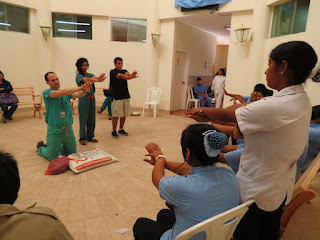June 19, 2012
(PHOP has arrived in Chincha this week and we will be posting updates from both Chincha and the Sacred Valley. For more information on the addition of the Chincha site to PHOP, click here.)
After a late night of reviewing CPR skills (RCP en español) with a couple of students, we entered day 2 in Chincha with a vague plan for teaching CPR courses to some native Peruvians. However, we were uncertain of how large classes would be, how many classes we would teach, or where classes would be held. Also, our manikins never made it to the Peru, so we were not sure what to use for demonstration. However, everything has a way of working out in Peru. Once we arrived in clinic, the time for the first class arrived quickly and we scavenged for supplies. The result was the manikin in the photo below: the body was a 50 kg bag of zinc sulfate, and the head was a fleece jacket stuffed into a trash bag. Importantly, the head also served a second purpose as our infant manikin. This was an exercise in maximizing resources, and they worked just fine.
(PHOP has arrived in Chincha this week and we will be posting updates from both Chincha and the Sacred Valley. For more information on the addition of the Chincha site to PHOP, click here.)
After a late night of reviewing CPR skills (RCP en español) with a couple of students, we entered day 2 in Chincha with a vague plan for teaching CPR courses to some native Peruvians. However, we were uncertain of how large classes would be, how many classes we would teach, or where classes would be held. Also, our manikins never made it to the Peru, so we were not sure what to use for demonstration. However, everything has a way of working out in Peru. Once we arrived in clinic, the time for the first class arrived quickly and we scavenged for supplies. The result was the manikin in the photo below: the body was a 50 kg bag of zinc sulfate, and the head was a fleece jacket stuffed into a trash bag. Importantly, the head also served a second purpose as our infant manikin. This was an exercise in maximizing resources, and they worked just fine.
The first
class started at 10:30 am, and we trained 36 Peruvian children from a local
school in Adult/Child/Infant CPR and choking response. With three of us students
leading the class, we explained and displayed these skills and had a few
participants volunteer to practice in front of the group. The participants were
a bit anxious at first, but after some coaxing and applause, we found a few
volunteers. At the end of the course, we received a round of applause, and all
of the school girls gave us kisses on the cheek as they left. Needless to say,
this class went much smoother than we had expected.
The second
class was similar to the first, but a smaller group of 10 nursing students.
This class was quite a bit more reserved, but we persistently nudged them into
participation. The third class, however, was the largest and most interesting
of the day. We started the class after a group of 20+ people showed up, but
then 10 minutes into the class, another two groups arrived. In total, we ended
up teaching around 50 people, including high school students, nursing
assistants from the clinic, and a few patients. As we were teaching the class,
I looked up and noticed a large group of people watching us from the second
floor. Not only were we helping to teach CPR, but we also served as
entertainment for patients! All in all, the CPR training was a success today.
We trained nearly 100 people and garnered a great deal of interest for the next
classes on Thursday. With flexibility and adaptability, we were able to teach
some life-saving skills! Not a bad day at all…
Lessons for
the day
1) Expect
anything in Peru
2) Creativity
helps to maximize utilization of resources
3) Choking
response garners the greatest interest and interactions from groups
4) Combining
a bag of pesticides and a stuffed trash bag really does make a fine manikin!
Bryan Sisk
Medical
Student, CCLCM


loved the mannikin and your creativity... raises a question about the need for a real mannikin and what does it add to justify the additional cost.
ReplyDelete